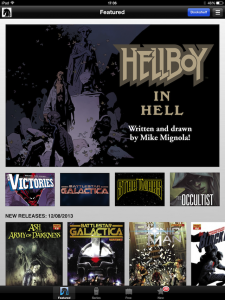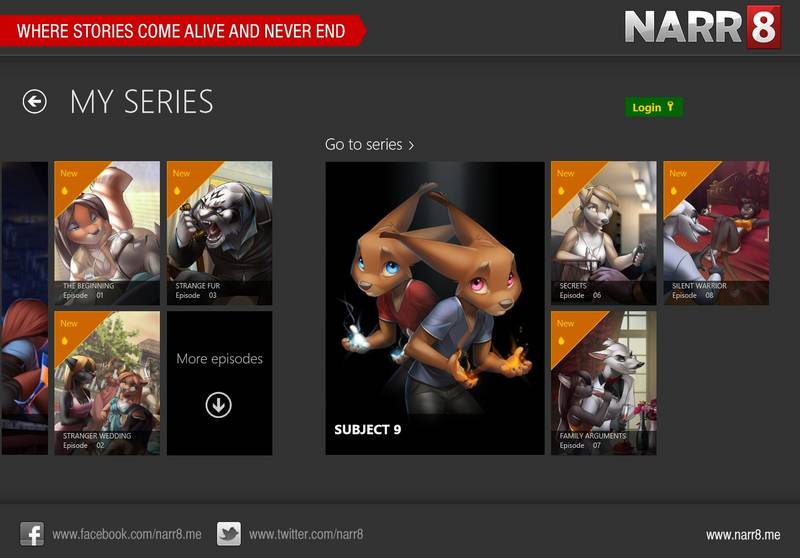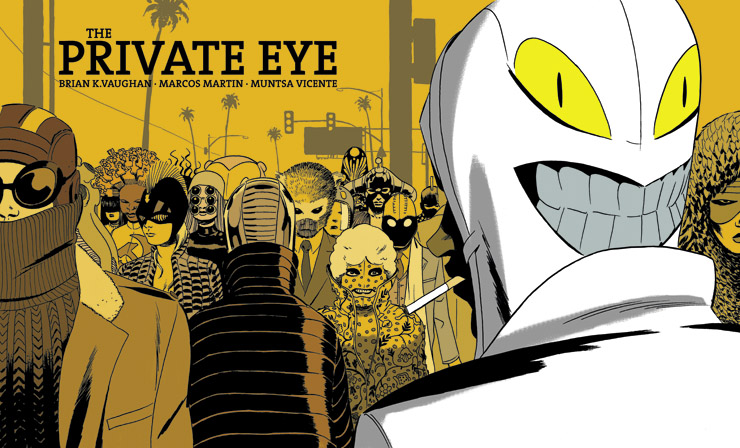The Complete Guide to Digital Comics (part 2) Madefire, motion books and the secrets of self publishing
 In the first part of our Complete Guide to Digital Comics we looked at the launch of the iPad and the growth of ComiXology and Guided View comics. However not every comic creator embraced this approach. For some the idea of being tied down to one revenue source, where their titles were locked to one format didn’t tally up with their egalitarian idea of the world of digital comics and and so they explored other avenues. While for others, ComiXology simply couldn’t offer them the kind of technological features they wanted in order to tell their stories and so thanks to the wild west nature of digital comics where anyone could succeed, they set out to create their own apps that could tell stories the way they wanted to. This is our guide to those intrpid creators…
In the first part of our Complete Guide to Digital Comics we looked at the launch of the iPad and the growth of ComiXology and Guided View comics. However not every comic creator embraced this approach. For some the idea of being tied down to one revenue source, where their titles were locked to one format didn’t tally up with their egalitarian idea of the world of digital comics and and so they explored other avenues. While for others, ComiXology simply couldn’t offer them the kind of technological features they wanted in order to tell their stories and so thanks to the wild west nature of digital comics where anyone could succeed, they set out to create their own apps that could tell stories the way they wanted to. This is our guide to those intrpid creators…
Dark Horse do it themselves

As ComiXology grew and grew, with more publishers joining their storefront on a regular basis, the most high profile publisher to not link up with them was Dark Horse Comics. The 4th largest publisher in the US their titles include Hellboy, the Goon, Conan the Barbarian, alongside licensed titles like Star Wars and Halo. Dark Horse preferred to develop their own app and storefront rather than rely on ComiXology and thanks to their strong collection of titles and the loyalty of their fanbase, Dark Horse remains the largest independent digital comic company outside ComiXology, and they aren’t alone as their app now includes titles from Dynamite Comics as well their own.
This was not their first attempt at releasing their comics digitally though as prior to launching the storefront app they had also developed their own app-based comics which were PDF versions of previously released titles like Hellboy: Wake the Devil , and they also produced a number of motion comics. These were done by animating previously released editions of hit series like Hellboy and Usagi Yojimbo to create a comic animation hybrid, commonly known as a motion books. Mixing sound and simple animation they were available to download as individual apps from the iTunes Store.
Madefire make the most of motion books.

Dark Horse’s approach of animating comics is not unique, however. The true pioneers of motion books for the iPad are Californian-based publishers Madefire, founded by former Marvel UK artist Liam Sharp alongside design mogul Ben Wolstenholme and Watchmen legend Dave Gibbons. Madefire’s digital comics are known as ‘motion books’ and are available via their free to download app and are the true cutting edge of digital comics. They mix stunning artwork from established names like Bill Sienkiewicz, and Mark Texeira with original titles from Sharp, Wolstenholme and Gibbons. With innovative layouts that mean stories aren’t confined to a traditional panel based structure, along with animating pages and ambient soundtracks, Madefire’s titles such as Treatment, Mono and The Engine regularly push the boundaries of what makes a digital comic. Indeed Sharp’s Captain Stone is Missing was so innovative it was voted the digital comic of the year for 2012 from this website for it’s cutting edge approach to story-telling. With many of the titles being free to download (or at least free to preview) they are essential reading and highlight just how exciting and innovative digital comics on the iPad can be.
Throughout 2013 Madefire have continued to innovate, releasing their motion books across the iPad and iPhone as well as making them available for free on your desktop thanks to a partnership with art community deviantART – where access to their motion book engine tool is also available. Meanwhile at the 2013 San Diego Comic Convention they announced a partnership with IDW Publishing to bring their licensed titles Star Trek, Transformer and My Little Pony to Madefire with new versions of existing stories given the Madefire motion book treatment. Also in 2014 Madefire are set to do the same to titles from Boom Studios and Top Cow.
Read our list of the 10 best digital comics apps that aren’t ComiXology here
Blurring the line between comics and animation
With their innovative use of motion book technology, Madefire’s digital comics blur the line between comics and animation, however they are still very much rooted in the comic book tradition. One company without that link who offer an even more advancecd approach to motion books are NARR8 from Russia.
NARR8‘s app uses a familliar storefront interface with titles available to buy for ‘NARRs’ – in-app credits which you can either purchase or acquire via regular visits. As well as NARR8‘s mixture of highly polished digital comics, they also have magazine style titles which use the same kind of slick interactivity to showcase their articles.

NARR8‘s books are most strongly influenced by the Japanese world of anime and so their brand of motion books rely much more on animated elements across a full screen rather than smartly animating comic book style panels. Their titles like Subject 9, Prime Blood and Final Feat are very cartoony but tell incredibly slick stories with very high production values and feel much more like watching a cartoon than reading a book giving the reader a much more active sense when reading the stories. NARR8‘s titles can also be read on the iPhone and on a desktop PC via Facebook and they also have a digital story builder similar to Madefire’s.
Taking things even further down the comic/animation avenue is Ryan Woodward’s Bottom of the Ninth which claims to be the world’s only animated graphic novel. Using his expertise as a Professor of Animation and former animator at Pixar, Woodward’s hybrid of animation and comic sees his characters quite literally moving within the panels on the page. With incredibly high production values, this series truly has to be seen to be believed.

While taking things another step away from the traditional printed idea of story-telling is Doug Lefler’s Scrollon which tells stories using horizontally scrolling long pages (based on the idea of Chinese scroll) which sees pages linked seamlessly together to create one long panel. All of these are available via the App Store and go to show that you don’t need a third party publisher to produce a stunning digital comic.
Read our list of the 5 best digital comics apps for iPhone
Adding value to your digital comics with enhanced extras!

As well as the pioneers spirit, one of the common themes among app-based digital self-publishers is the idea of adding more value to their digital comics beyond that of a traditional page turner. In the world of ComiXology we see companies offer digital exclusive extras like extra pages and sketches, but in the world of app-based publishing, publishers can go even further. One such company offering this kind of feature rich product is Sequential – the graphic novel app. Founded by publisher Russell Willis who had previously created standalone apps for reprints of classic British comics like Eddie Campbell’s Dapper John and David Lloyd’s Kickback. However rather than adding animation or extra elements to the story, Panel Nine preferred to follow the DVD extras path and offer a creator’s commentary track across their titles. With exclusive insights from the wrtiers it helped give the series a truly unique feel and helped give them a new lease of life for a new audience. Panel Nine‘s titles evolved into Sequential, to create a storefront containing this enhanced graphic novels as well as republishing several independent British-based graphic novels such as Alan Moore’s League of Extraodinary Gentlemen and titles from British publishers like Jonathan Cape.
Another team who followed a similar approach are Cognito Comics the creators of CIA: Operation Ajax, a digital comic based on the 1953 Iranian coup which mixes digital comic action with historically accurate facts, including real life news footage from the time, character dossiers and real-life CIA documents, which help give the story a much more comprehensive amount of detail than a flat page-turner ever could.
DIY digital publishing
For those for whom digital publishing via ComiXology or the App Store is too restrictive then the world of digital comics still has a whole self sufficient subset that doesn’t even require the use of an iPad! The ability to self publish digital comics has helped level the playing fields for many comic writers and artists by removing the need to sign distribution deals or worry about print costs. Sites like DriveThru Comics or Comicsy in the UK offer creators a portal for selling easily downloadable PDFs or CBR and CBZ files allowing more comic creators than ever before to have their work seen. While creators like David ‘V For Vendetta’ Lloyd have even created their own publishing models, in the form of Lloyd’s Aces Weekly which offers readers a subscription based service for an online digital art comic featuring big names from the UK comic scene.
But it’s not just wannabe indie creators who are following these models. Long before the iPad, in the UK, weekly science-fiction stalwart 2000AD was releasing it’s comics as DRM-free CBZ and CBR files for fans (now they also have a version available via Apple’s Newsstand) and more recently Image Comics started to release hit titles like Saga and The Walking Dead via their own DRM-free store.
Digital godfather Mark Waid has also pushed forward the world of digital self publishing with his Thrillbent brand, which offers weekly instalments of digital comics for free (like a webcomic) before releasing collected editions of titles like Moth City, The Eighth Seal and The Endling via ComiXology once they have been published online. And fantasy writer Joe Abercrombie has done similar things with his TheBlade Itself: The First Law series, while Brian K Vaughan, creator of the critically acclaimed Saga series for Image Comics, also releases his own digital comic The Private Eye, via his website Panel Syndicate.
Both Vaughan and Waid take this process one step further by offering a ‘pay what you choose’ model which we have seen in the music industry as well, with bands like Radiohead offering albums to fans for a price of their choosing.

Although this kind of payment structure relies on a certain kind of notoriety and a pre-defined fanbase to work, the ‘democratisation’ of digital comics has been further aided with the growth of crowd sourcing for financing digital comics. Titles like Joe Martino’s The Mighty Titan and Jamal Igle’s Molly Danger, are amongst thousands of titles looking for money via websites like Kickstarter, and go to show that there is no longer a straight forward way to get into digital comics.
Hopefully that has now given you some insight into the world of digital comics on the iPad, iPhone and on any digital device you can mention. Keep reading Pipedream Comics for more news, reviews and interview discussing the wonderful world of digital comics and you will hopefully see that thanks to the digital revolution we are now truly in second golden age for comics.
December 19, 2025 @ 11:59 pm
Dank des aufregenden Fatpirate no deposit bonus
können Sie sofort loslegen, ohne eine Einzahlung vornehmen zu müssen. Willkommensboni, regelmäßige Aktionen und ein Treueprogramm mit exklusiven Privilegien machen dieses Casino bei den Nutzern beliebt.
Fat Pirate Casino bietet verschiedene Zahlungsmöglichkeiten für Ein- und Auszahlungen an.
Das Treueprogramm mit mehreren Stufen bietet Privilegien, darunter erhöhte
Auszahlungslimits, persönlichen Service und Cashback.
Fat Pirate Casino bietet eine große Auswahl an Spielen von bekannten Anbietern, Bonusangebote und ein durchdachtes Treueprogramm.
Fat Pirate versteht das und bietet eine hochwertige mobile Version der Website.
References:
https://online-spielhallen.de/arena-casino-cashback-dein-ratgeber-fur-ruckerstattungen/
December 26, 2025 @ 2:17 pm
Ltd, indicated that the app’s privacy practices may include handling of data as described below.
Additionally, Ticketnew provides a user-friendly more With over 2000 cinemas/theatres (and counting), you can catch all the latest movies in town with the
best seats in the house.
Chatbots can make it easy for users to find information by instantaneously responding
to questions and requests through text input, audio input, or both, without the need for
human intervention or manual research. True to its promise
of not requiring any code, the course teaches how
to visually create chatbots with Watson Assistant and how to deploy them online through
a handy WordPress plugin. Learn to create useful chatbots
without writing any code in IBM’s Building AI Powered Chatbots Without Programming course.
Looking to leverage the benefits of chatbots in your job?
References:
https://blackcoin.co/brand-new-casinos-online-in-australia-2025-a-comprehensive-guide/
December 27, 2025 @ 4:37 am
Try your luck at the freshly rebuilt casino, which
has a total area of 65,000 square feet. With award-winning restaurants and five bars, there’s plenty to do.
Alternatively, you might relax in your 5-star hotel room and take in the beautiful scenery from your suite.
Before you attend the latest stage play, meet up with
friends and have a meal before the night begins, or taste
from the incredible buffet. There are over six restaurants, and their website offers a handy online
table reservation option. After hours, choose from
outdoor bars, sports bars, or the neighborhood’s hotspot, The
Atrium Bar. You may enjoy lush manicured grounds, an enviable location, and five-star comfort whether you
stay at The Star Grand or The Darling. There are also spa services,
an outdoor pool area, and private cabanas.
References:
https://blackcoin.co/top-10-popular-casino-games-trends-innovations-in-igaming/
December 29, 2025 @ 7:41 am
us online casinos that accept paypal
References:
https://careers.tu-varna.bg/employer/paypal-casinos-2025-best-online-casinos-accepting-paypal/
December 29, 2025 @ 8:13 am
paypal casinos online that accept
References:
realhire.co